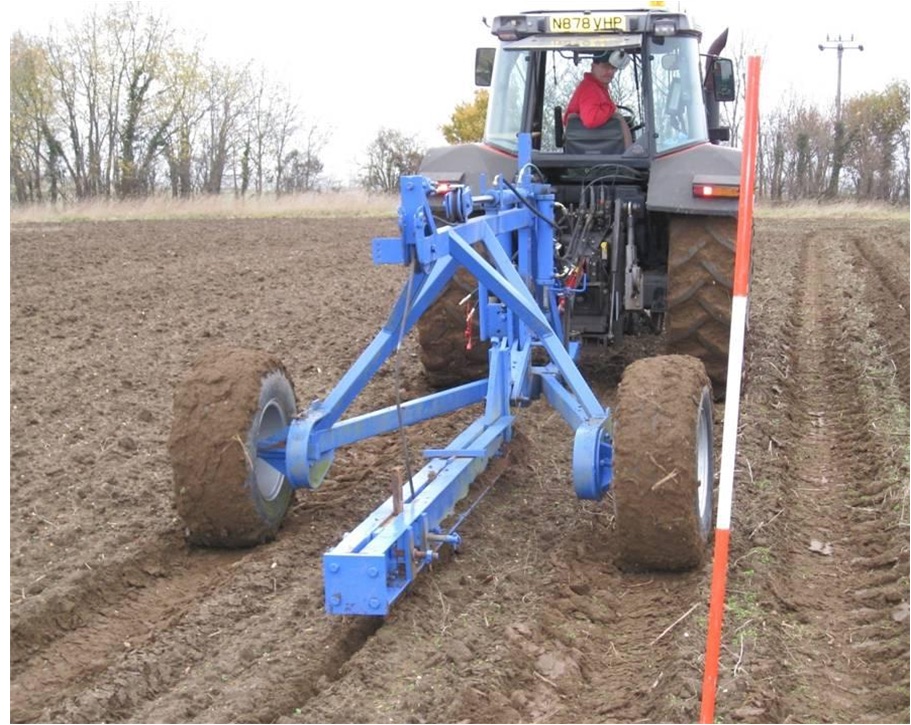
Features
Drainage Management Systems
U.K. Update
U.K. Update: Mole drainage
Mole plowing sees a resurgence in the U.K. after some wild weather.
December 7, 2020 By Rob Burtonshaw

Photo credit: Richard Godwen
Here in the U.K. mole plowing (ploughing) is back in fashion.
Mole plowing is a secondary drainage technique that aims to link the surface with the primary drainage (or piped drainage) scheme below ground. It is very dependent on soil type and provides effective drainage on heavy clay soil which tends to crack rarely and then only in the height of summer. It would probably do more harm than good on light soils and on soils where pockets or lenses of sandy or gravely material are present. It does not help control the water table, it helps speed up infiltration from the surface.
Mole drainage creates underground tunnels for water, similar to tile drainage but without the pipe. The idea is to pass a bullet on the end of a leg through to soil, creating a void or channel for water to run. When combined with a piped drainage scheme with a permeable backfill, water is able to run down the cracks and fission created by the leg of the mole plow, into the void and then to the permeable fill for before flowing into the pipe.
Mole drainage creates underground tunnels for water, similar to tile drainage but without the pipe.
Ideally the depth of these mole plow voids should be around 600 millimeters (mm) (24 inches) to protect them from surface traffic. They need to be shallow enough not to damage the existing pipework and to pass through the column of permeable backfill laid over the top of the pipe. The bullet which forms the void is followed by an expander, which not only increases the size of the void but consolidates the sides. The void is normally at least 75 mm in diameter and mole channels are normally less than three parts apart. Mole channels should be drawn across any existing drainage preferably at right angles if the fall will allow. Forward speed is also important. Move too fast through the soil and the void will not have time to consolidate, often as little three miles per hour (mph) is considered to be the right speed.
Forward speed is also important. Move too fast through the soil and the void will not have time to consolidate, often as little three miles per hour (mph) is considered to be the right speed.
For mole plows to last, the conditions must be correct. Soils need to be damp enough at depth (a true plasticine), yet dry enough on top to allow cracks and fission to develop and also to give enough traction to pull the mole plow. I have known many people say that heavy rain straight after mole plowing is a problem, because if the voids have not had time to harden the water can gouge the voids causing fatal damage. Normally moles last up to seven years, but there are no hard and fast rules, with stories abound of mole channels lasting more than 20 years.
Normally moles last up to seven years, but there are no hard and fast rules, with stories abound of mole channels lasting more than 20 years.
Studies, admittedly rather old studies, show considerable yield increases when mole plowing is done correctly. So why did it go out of fashion for some landowners? Well for starters, it takes a long time and is often rather a dull job. At a time when the number of staff on a farm has been reducing, a lack of man hours is a problem. The ideal conditions for mole plowing (dry on top, damp below) are normally found in late spring, which is also a time when most farmers’ crops are in the ground in the U.K. Mole plowing also has the capability to make a wet field worse if it is not done correctly or if it is done on the wrong soil type. Moving water from the surface to another area in the soil profile and concentrating that water in one place does not help with drainage, moles only work if connected to a suitable outlet. One messy mistake can put people off mole drainage for life.
Last autumn and winter were extremely wet and many drainage issues became so bad that farmers could not avoid the problem anymore.
Why is it back in fashion here? The weather of course. Last autumn and winter were extremely wet and many drainage issues became so bad that farmers could not avoid the problem anymore. To compound matters, the spring was exceptionally dry creating one of the worst harvests in living memory. The new-found popularity of mole plowing is also linked to the continuing focus on soil health and improving yield without expensive inputs. Sometimes innovation is not new ideas, but older ideas repurposed for a different time. And if it gets people thinking about drainage, I’m happy.
Print this page